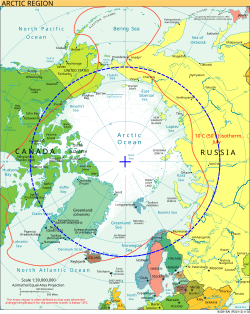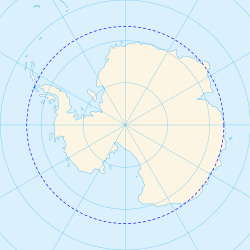Difference between revisions of "AY Honors/Midnight Sun/Answer Key"
JadeDragon (talk | contribs) |
JadeDragon (talk | contribs) |
||
| Line 8: | Line 8: | ||
==1. Describe the geographic areas the midnight sun may be seen in.== | ==1. Describe the geographic areas the midnight sun may be seen in.== | ||
| − | The '''midnight sun''' is a natural phenomenon that occurs in the summer months in places north of the Arctic Circle | + | The '''midnight sun''' is a natural phenomenon that occurs in the summer months in places '''north of the Arctic Circle''' and '''south of the Antarctic Circle''', when the sun remains visible at the local midnight. |
[[Image:Arctic_circle.svg|thumb|200px|The Arctic Circle - blue ring]] | [[Image:Arctic_circle.svg|thumb|200px|The Arctic Circle - blue ring]] | ||
Revision as of 00:04, 19 September 2014
1. Describe the geographic areas the midnight sun may be seen in.
The midnight sun is a natural phenomenon that occurs in the summer months in places north of the Arctic Circle and south of the Antarctic Circle, when the sun remains visible at the local midnight.
Locations where the sun is less than 6 or 7 degrees below the horizon which are above 60° 34’ latitude that are south of the Arctic Circle or north of the Antarctic Circle experience midnight twilight instead, so that daytime activities, such as reading, are still possible without artificial light on a clear night. White Nights have become a common symbol of Saint Petersburg, Russia, where they occur from about June 11 to July 2, and the last 10 days of June are celebrated with cultural events known as the White Nights Festival.
2. Describe why and at what time of the year the phenomenon may be seen.
Around the summer solstice (approximately June 21 in the north and December 22 in the south) the sun is visible for the full 24 hours, given fair weather. The number of days per year with potential midnight sun increases the farther towards either pole one goes. Although approximately defined by the polar circles, in practice the midnight sun can be seen as much as 90 km outside the polar circle, and the exact latitudes of the farthest reaches of midnight sun depend on topography and vary slightly year-to-year.
The phenomenon is caused by the Earth's axial tilt, which at the solstice tilts one pole away from the sun (polar night), and tilts the other towards the sun (the midnight sun). This is easily illustrated with a globe and a flashlight, by observing which parts of the globe are illuminated (or in shadow) as the globe rotates on its axis, and as the globe orbits around the "sun" (or in our case, the flashlight).
3. Find a place where you can observe the sun at its lowest position during the night and do the following:
a) Calculate the exact time for the sun's lowest position (take into consideration daylight saving time if applicable).
The sun's lowest position occurs when the sun is due north. At this instant, the shadow cast by a gnomen (a perfectly vertical pole) will point due south.
You can figure out the time that this happens at your location by using planetarium software, such as Stellarium which is free and is available for many type of computers. To do this, set your observation location to where you are, and then set the time to midnight. Check the position of the sun - is it east of north, west of north, or due north? If it's too far east, set the time a little later. If too far west, set the time a little earlier. Continue refining the time until the sun is due north.
You can also calculate the time of solar noon using charts as described at http://www.spot-on-sundials.co.uk/localtime.html - and then add twelve hours to get the time of the midnight sun.
b) Stay awake until the sun has reached its lowest position and take a landscape picture that shows the sun and some surrounding nature. Make sure not to look directly into the sun without proper protection.
Upload your photos here and add them to our wiki!
c) Look around you and take note of how the nature reacts to the continuous sunlight.
Animals will still need to sleep. What else do you see?
d) Find information on the time period the midnight sun phenomenon is visible at your point of observation.
At North Cape, Norway, known as the northernmost point of Continental Europe, this period extends approximately from May 14 to July 29. On the Svalbard archipelago further north this period extends from April 20 to August 22. The further north you go, the longer the midnight sun lasts. (NEED a way to tell the dates...)
4. For what period of the year is the sun visible at each of the poles?
At the poles themselves, the sun only rises once and sets once each year. During the six months when the sun is above the horizon it spends the days continuously moving in circles around the observer, gradually spiraling higher and reaching its highest circuit of the sky at the summer solstice.
The polar sunrise happens at the spring equinox, and the polar sunset happens on the autumnal equinox.
5. What is the “polar night”?
The opposite phenomenon of the midnight sun is the polar night, which occurs in winter when the sun stays below the horizon throughout the day.
6. Read Genesis 1:31-2:3, Leviticus 23:32, Exodus 20:8-11 and Nehemiah 13:15-22 and discuss in a group (or in written form – at least 500 words) when the Sabbath starts according to the Bible and how this can be applied in areas that experience midnight sun and polar night.
7. Talk to at least 5 persons that have lived or currently live in an area with midnight sun and ask them how the midnight sun and polar night affect their life.
If you do not live in the polar region, this is going to take a little work. You might look around for people that have lived up North, or try internet chat forums for contacts. Simply calling people (like in a tourist office, park or government office) in Northern areas should work.
For example, the US National Parks Service runs the Inupiat Heritage Center in Barrow, AK Visitor Information 1-907-852-0422
Communities North of the Arctic Circle
The largest European communities north of the Arctic Circle are Murmansk, Russia (population 307,257), Norilsk, Russia (175,365), Tromsø, Norway (71,295), and Bodø, Norway (49,000). Rovaniemi, Finland (60,000) lies slightly south of the line and is the largest settlement in the immediate vicinity of the Arctic Circle.
The largest North American community north of the Arctic Circle is Sisimiut, Greenland with 5,000 inhabitants. Of the Canadian and United States Arctic communities, Barrow, Alaska is the largest settlement with 4,000 inhabitants.
Effects
Among the people of the Arctic, the Norwegians have the easiest climate, with most ports in North Norway remaining ice-free all the year as a result of the Gulf Stream.
Many find it difficult to sleep during the night when the sun is shining. In general, visitors and newcomers are most affected. Some natives are also affected but usually to a lesser degree. The midnight sun is said to cause hypomania, which is characterized by persistent and pervasive elevated or irritable mood.
The midnight sun is also an issue for those who observe religious rules based around the 24 hour day/night cycle.
In the Jewish community there is a body of law which attempts to deal with adherence to the Mitzvah in such conditions.
Another affected religion is Islam, where fasting during daylight hours in Ramadan would imply total abstinence. Also, Muslims have 5 obligatory prayers daily which are timed according to position of the sun, so it becomes difficult for them to decide the prayer times; however, they can follow the timings of the closest place that has a normal sun cycle or the timings of Mecca, the holiest city of Islam.
What else can you discover? Please add it to this wiki.


